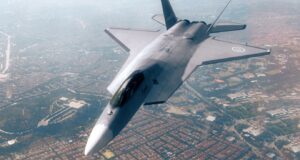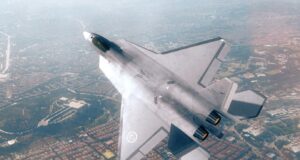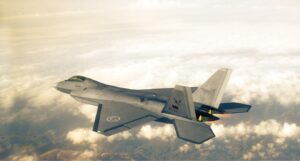Aerospace
Meet Turkey’s home built 5th gen fighter jet TF x : Specification, speed, Engine and Weapons

Welcome back to Jetline marvel. Meet Turkish Aerospace Industry’s TF X. It has a stealth twin engine and all-weather air superiority for the fifth generation. The F16 Fighting Falcons of the Turkish Air Force will be replaced with this aircraft, which will be exported to other countries. By March 2023, this aircraft will be unveiled, and it will take to the skies for the first time in 2025.
The TFX is a fifth-generation fighter that looks a lot like the F-35 Lightning II from Lockheed Martin. The indigenous planes will eventually replace the Turkish Air Force’s F-16 fighter jets, which are scheduled to be phased out by the 2030s.
Turkey will become one of the few countries having the technology, technical infrastructure, and capabilities to build a fifth-generation (or beyond) fighter plane.
TFX’s full-scale mock-up debut in Singapore could be geared towards identifying possible Asian partners. TAI has been working in the Asian market to strengthen collaborations in next-generation technologies, especially in the defence and aviation sectors.
The TF-X is the first 5th-generation aircraft to be designed and manufactured using digital twin technology. Until the TAEC engine is available, prototypes will be powered by General Electric F110 engines.
How has Boeing’s B787 dreamliner turned into a nightmare?
TF x has Upgraded versions of Aselsan’s own radar warning receiver, missile warning system, laser warning system, chaff and flare management would most likely be used on the aircraft. It has a dispensing system as well as a digital radio frequency memory-based jamming system, both of which have been employed on other air platforms.
The length of this aircraft is 21 meters, the wingspan is 14 meters, and the height is 6 meters.
The maximum take-off weight for this aircraft is projected to be 27,215kg.
For the test, it includes a power plant of two GE F110 engines, each capable of producing 120 kilo newton’s of thrust.
It has a top speed of 2,470 km/h, a combat range of up to 1,100 kilometers, and a service ceiling of 55,000 feet.
What is the Boeing P-8I in the Indian Navy used for?
It can carry a wide range of weapons. It has indigenously developed Goktug missiles and imported MBDA meteor air-to-air missiles.
It also has air-to-surface missiles such as the SOM cruise missile B1,2,3 and the indigenously developed Kuzgun TJ air-to-surface missile, as well as anti-radiation missiles, anti-ship, air-to-surface, cruise missiles, and the MBDA spear 3, as well as many other weapons to be added to the TF x aircraft.
Did you know these 10 incredible facts about Honda jet ?

Aerospace
Boeing Transfers Rocket Stage to NASA, Paving Way for Human Moon Mission

Boeing has achieved a significant milestone by providing NASA with the second core stage of the Space Launch System (SLS) rocket.
This crucial component, crafted at NASA’s Michoud Assembly Facility (MAF), is set to propel the Artemis II crew into lunar orbit, marking humanity’s return to deep space after a 50-year hiatus.
The monumental Boeing-built rocket stage, the largest element of the Artemis II mission, will embark on a journey aboard the Pegasus barge, traveling 900 miles to NASA’s Kennedy Space Center.
Comparison of two legendary aircraft B777x vs B747 aircraft:Click here
Upon arrival, it will be meticulously integrated with other essential Artemis II components, including the upper stage, solid rocket boosters, and NASA’s Orion spacecraft within the iconic Vehicle Assembly Building. This intricate integration process is a vital step toward the eagerly anticipated Artemis II launch, slated for 2025.
“Boeing-built products helped land humankind on the moon in 1969, and we’re proud to continue that legacy through the Artemis generation,” remarked Dave Dutcher, vice president and program manager for Boeing’s SLS program. “Together, with NASA and our industry partners and suppliers, we are building the world’s most capable rocket and paving the way to deep space through America’s rocket factory in New Orleans.”
NASA, Lockheed Martin Reveal X-59 Quiet Supersonic Aircraft:Click here
The delivery of Core Stage 2 marks a significant achievement in the evolution of the SLS rocket. Towering over 200 feet and powered by four RS-25 engines, this core stage, coupled with two solid-fueled booster rockets, will generate a staggering 8.8 million pounds of thrust. This immense power is crucial to launching Artemis II and future missions into the vast expanse of space.
The SLS rocket stands unparalleled in its capability to transport both crew and substantial cargo to the moon and beyond in a single launch. Its extraordinary capacity will facilitate the delivery of human-rated spacecraft, habitats, and scientific missions to destinations including the moon and Mars, ushering in a new era of space exploration.
-

 Travel1 week ago
Travel1 week agoAir India to Expand US Operations with Three New Routes After a Decade
-

 Travel2 weeks ago
Travel2 weeks agoWhy We Should Avoid These Stamps in a Passport
-

 Airlines1 month ago
Airlines1 month agoInvestigations Reveal Fake Chinese Titanium in Boeing and Airbus Jets
-

 Tech4 weeks ago
Tech4 weeks agoChina’s CATL Plans 1,800-Mile Electric Plane Launch by 2027
-

 Airport3 days ago
Airport3 days agoTop 10 Largest Airports in the World by Size
-

 Aerospace4 weeks ago
Aerospace4 weeks agoChina’s Fighter Jets Turn Wings into Autonomous Drones
-

 Airlines4 days ago
Airlines4 days agoAir India Rolls Out A350s for Delhi-New York JFK and Newark Routes
-

 Defence3 weeks ago
Defence3 weeks agoBoeing Enhances Chinook with New Engines and Block II Upgrades at $96 Million










